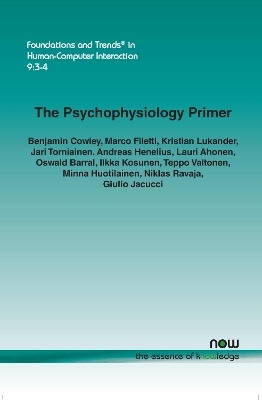
The Psychophysiology Primer
A Guide to Methods and a Broad Review with a Focus on Human?Computer Interaction
Seiten
2016
now publishers Inc (Verlag)
978-1-68083-198-6 (ISBN)
now publishers Inc (Verlag)
978-1-68083-198-6 (ISBN)
Provides a foundational review of the field of psychophysiology to serve as a primer for the novice, enabling rapid familiarisation with the core concepts, or as a quick-reference resource for advanced readers. The book places special emphasis on everyday human–computer interface applications.
Digital monitoring of physiological signals can allow computer systems to adapt unobtrusively to users, so as to enhance personalised ‘smart’ interactions. In recent years, physiological computing has grown as a research field, and it is increasingly considered in diverse applications, ranging from specialised work contexts to consumer electronics. Working in this emerging field requires comprehension of several physiological signals, psychophysiological states or ‘indices’, and analysis techniques. The resulting literature encompasses a complex array of knowledge and techniques, presenting a clear challenge to the practitioner.
The Psychophysiology Primer provides a foundational review of the field of psychophysiology to serve as a primer for the novice, enabling rapid familiarisation with the core concepts, or as a quick-reference resource for advanced readers. It places special emphasis on everyday human–computer interface applications, drawing a distinction from clinical or sports applications, which are more commonplace.
This primer provides the reader with a framework of commonly understood terms associated with experiential constructs and physiological signals. Then, 12 short and precisely focused review sections describe 10 individual signals or signal sources and present two technical discussions of online data fusion and processing. A systematic review of multimodal studies is provided in the form of a reference table. It concludes with a general discussion of the application of psychophysiology to human–computer interaction, including guidelines and challenges.
Digital monitoring of physiological signals can allow computer systems to adapt unobtrusively to users, so as to enhance personalised ‘smart’ interactions. In recent years, physiological computing has grown as a research field, and it is increasingly considered in diverse applications, ranging from specialised work contexts to consumer electronics. Working in this emerging field requires comprehension of several physiological signals, psychophysiological states or ‘indices’, and analysis techniques. The resulting literature encompasses a complex array of knowledge and techniques, presenting a clear challenge to the practitioner.
The Psychophysiology Primer provides a foundational review of the field of psychophysiology to serve as a primer for the novice, enabling rapid familiarisation with the core concepts, or as a quick-reference resource for advanced readers. It places special emphasis on everyday human–computer interface applications, drawing a distinction from clinical or sports applications, which are more commonplace.
This primer provides the reader with a framework of commonly understood terms associated with experiential constructs and physiological signals. Then, 12 short and precisely focused review sections describe 10 individual signals or signal sources and present two technical discussions of online data fusion and processing. A systematic review of multimodal studies is provided in the form of a reference table. It concludes with a general discussion of the application of psychophysiology to human–computer interaction, including guidelines and challenges.
1: Introduction
2: Definitions
3: The state of the art
4: Overview and application
5: Concluding remarks
References
| Erscheinungsdatum | 14.11.2016 |
|---|---|
| Reihe/Serie | Foundations and Trends® in Human-Computer Interaction |
| Verlagsort | Hanover |
| Sprache | englisch |
| Maße | 156 x 234 mm |
| Gewicht | 254 g |
| Themenwelt | Informatik ► Software Entwicklung ► User Interfaces (HCI) |
| Informatik ► Theorie / Studium ► Künstliche Intelligenz / Robotik | |
| ISBN-10 | 1-68083-198-4 / 1680831984 |
| ISBN-13 | 978-1-68083-198-6 / 9781680831986 |
| Zustand | Neuware |
| Haben Sie eine Frage zum Produkt? |
Mehr entdecken
aus dem Bereich
aus dem Bereich
Aus- und Weiterbildung nach iSAQB-Standard zum Certified Professional …
Buch | Hardcover (2023)
dpunkt Verlag
CHF 48,85
Lean UX und Design Thinking: Teambasierte Entwicklung …
Buch | Hardcover (2022)
dpunkt (Verlag)
CHF 48,85
Wissensverarbeitung - Neuronale Netze
Buch | Hardcover (2023)
Carl Hanser (Verlag)
CHF 48,95


